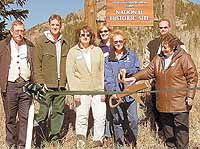| Speakers involved in the ribbon cutting celebration of the Scenic Byway include Steven Taylor, Bill Broadbear, Deb Dull, Margaret Godfrey, Kathy Hanna Smith, Joan Taylor, and Dave Gerrard. |
The first Scenic Byway in Utah, the Huntington and Eccles Highway, was given that designation in 1987. Since then 26 other scenic byways have been named in the state. But the first one, also known as the Energy Loop, was recognized and honored with a ribbon cutting ceremony in mid-October at the Stuart Guard Station.
Local officials from three counties and several agencies representing tourism, industry, media, economic development and forest service were in attendance as new signage for the scenic byway was unveiled. The Huntington and Eccles Canyons Scenic Byways are two routes in the Utah state system that offer outstanding beauty and interest. These two byways traverse portions of the Manti-La Sal National Forest, managed by the United States Department of Agriculture’s Forest Service.
In her opening remarks Kathy Smith, Carbon county tourism chief said that, “Roads no longer merely lead to places, they are places and as they say in Utah, this is the place.” She was referring to the Huntington and Eccles National Scenic Byways. “Thank goodness for Rosann Fillmore and others that kept us on track during the corridor management plan process.” If agencies choose to pursue national designation, the next step is to prepared a CMP or a corridor management plan. The CMP provides a comprehensive understanding of the route and the community plans to preserve and enhance it. A CMP is also a living document that shows the strategies and efforts made by the community and in this case communities made up of Carbon, Emery and Sanpete to preserve and enhance the route. The group met repeatedly during the process in all three counties with elected officials, tourism agencies state and government agencies and the general public. It was the consensus to make this road a national scenic byway.
Joan Taylor serves as the coordinator of this scenic byway.
Smith pointed out that in describing a scenic byway, it is important both to identify the qualities that distinguish it from other roadways in the area and across the nation and to describe the resources. “A byway’s intrinsic qualities then become the focus of some combination of protection and promotion,” explained Smith.
A byway story is the intentional and coordinated message that the byway conveys to visitors about the resources and qualities that it promotes. Smith pointed out that the byway story is conveyed through the direct experiences that the visitor encounters along the trip.
The National Scenic Byways program defines six intrinsic qualities that provide the basis for scenic byway designation: archeological, cultural, historic, natural, recreational and scenic. “We have promoted this byway with these six qualities which we believe provide the framework for activities to promote tourism along the byway and to the portal communities of the energy Loop of Huntington Canyon and Eccles National Canyons.
Smith acknowledged the Manti La Sal National Forest for providing and maintaining the committees with a great product to promote camping, trails, amenities. “We have the greatest looking and well cared for national forest in the state,” said Smith. She recognized Ann King for playing an integral part in the byway program. Smith also cited Margaret Godfrey with the Utah State Travel council for guiding the committee through the grant process each year. On hand for the ceremony was Dave Gerrard, owner of Sign Edge, who, “has been patient for the last two years during the planning and designing stages of the signs and he is one of the reasons I am proud to be here today.”
Steve Tanner, resident poet and artist prepared and read a poem he prepared just for the celebration, talking about the history, beauty, and description of each area the byway covers.
Smith thanked Joan Taylor, the byway coordination, “she has overseen this byway for the last year and done it with ownership to the road. She has come up with great ideas to enhance our ability to promote additional sites along the byway that will have great benefits to the portal communities of the Energy Loop.”
Sponsors of the celebration, Utah Power, Pacific Corp., and Energy West Mining was represented by Debra Dull. On behalf of the three energy facilities, she thanked the Castle Country Travel Council for achieving national recognition of the byway. “The company was very pleased when the byway was named the Energy Loop since there is such a rich and colorful history concerning energy in this area,” said Dull.
Two of the energy facilities are situated along the byway, the Huntington Power Plant and the Deer Creek Coal Mine that supplies coal to the plant. Along with the coal that is mined, the water for the plant is extracted from the Huntington River which flows along part of this scenic byway. Both of these natural resources, coal and water, are necessary in the production of power generation, explained Dull.
Bill Broadbear, recreational director for the forest service discussed the numerous recreational opportunities along the byway. He also spoke of the beauty, reseeding projects and gave an overview of the Stuart Guard Station.
Stuart Guard Station offers a glimpse of the simple, rugged lifestyle of a forest ranger in the 1930s. From the station a ranger would go out each day on horseback or on foot to patrol the forest. He would oversee grazing, timber sales and be on the outlook for fires.
The byways were dressed up with three new double sided signs, one on each entrance.

